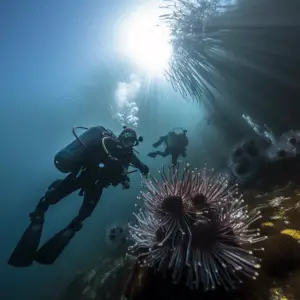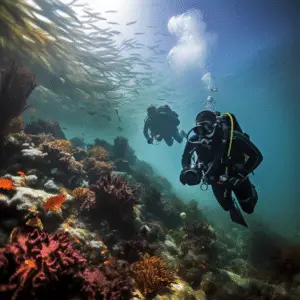
Monterey Bay diving, located on the central coast of California, is a haven for divers seeking to explore the wonders of the underwater world.
With its rich biodiversity and diverse marine ecosystems, Monterey Bay offers a unique and captivating diving experience.
In this article, we will dive into the depths of Monterey Bay, discovering the marine life, kelp forests, and extraordinary dive sites that make it a paradise for underwater enthusiasts.
Monterey Bay: A Marine Wonderland
Monterey Bay is renowned for its extraordinary marine biodiversity and its designation as a National Marine Sanctuary.
The bay’s diverse habitats, including rocky reefs, sandy bottoms, and extensive kelp forests, support a vast array of marine life.
The combination of nutrient-rich waters, upwelling currents, and protection provided by the sanctuary status has made Monterey Bay a thriving ecosystem and a dream destination for divers.
Kelp Forests: Underwater Giants
One of the most iconic features of Monterey Bay is its majestic kelp forests.
These towering underwater forests, comprised mainly of giant kelp (Macrocystis pyrifera), create a magical environment for divers to explore.
As you descend into the depths, you’ll find yourself immersed in a world of swaying kelp fronds, providing shelter and food for a multitude of marine creatures.
The kelp forests of Monterey Bay are home to an abundance of marine life, including fish, invertebrates, and marine mammals.
Diving Highlights
Point Lobos State Natural Reserve
Point Lobos State Natural Reserve is a world-renowned dive site, known for its stunning beauty and incredible biodiversity.
The reserve encompasses a network of dive sites, each offering a unique experience.
Divers can explore the iconic Bluefish Cove, with its vibrant marine life and underwater rock formations, or venture to the deeper depths of Whalers Cove, where the possibility of encountering larger marine species, such as sea lions or even leopard sharks, awaits.
Lover’s Point
Lover’s Point is a popular dive spot located in Pacific Grove, near Monterey.
This picturesque location offers an excellent entry point for divers and provides access to a variety of underwater attractions.
Divers can explore the rocky reefs, swim through kelp forests, and encounter an abundance of marine life, including colorful fish, invertebrates, and playful sea otters.
The shallow depths and calm conditions make Lover’s Point a great spot for divers of all skill levels.
Cannery Row
Cannery Row, made famous by John Steinbeck’s novel of the same name, is not only a vibrant cultural hub but also a fantastic dive location.
The area features a series of artificial reefs created by the remnants of the former sardine canning industry.
These structures have become home to a diverse array of marine life, including lingcod, rockfish, and various invertebrates.
Exploring the underwater landscape amidst the remnants of Monterey’s industrial past adds a unique historical dimension to the diving experience.
Marine Life Encounters
Diving in Monterey Bay provides ample opportunities to encounter an impressive variety of marine species.
From the smallest nudibranchs to the largest marine mammals, the bay is teeming with life.
Divers can spot playful sea otters, graceful sea lions, and the occasional harbor seal.
Schools of fish, including rockfish, sardines, and anchovies, move in synchronized harmony, creating a mesmerizing spectacle.
The bay is also a popular feeding ground for migrating humpback whales, gray whales, and even orcas, offering unforgettable encounters for lucky divers.
Conservation Efforts
Preserving the ecological integrity of Monterey Bay is crucial to ensure the long-term health and sustainability of its marine ecosystems.
The Monterey Bay National Marine Sanctuary, along with various conservation organizations and local communities, works tirelessly to protect and conserve the bay’s natural resources.
Efforts include sustainable fishing practices, marine debris cleanups, and education initiatives to raise awareness about the importance of conservation among divers and the general public.
As divers, we can contribute to these conservation efforts by practicing responsible diving techniques.
This includes respecting the marine life and habitats, properly disposing of waste, and participating in citizen science programs to help monitor and protect the bay’s biodiversity.
Conclusion
Diving in Monterey Bay is a truly awe-inspiring experience,
offering a glimpse into the diverse and vibrant world beneath the surface.
From the mesmerizing kelp forests to the encounters with magnificent marine species,
every dive is a new adventure waiting to unfold.
As we explore the underwater wonders of Monterey Bay,
let us remember the importance of preserving and protecting this marine paradise for future generations of divers to enjoy.
So,
don your scuba gear, immerse yourself in the depths,
and discover the giants of Monterey Bay’s underwater realm.

